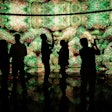
Rachel Bradshaw is the vice president of account services at Caster Communications, a PR and consulting agency serving technology clients spanning innovative startups, global fortune 500 companies, and industry-shaping consortia. With over 15 years of experience in both technology and live events, Bradshaw advises clients on strategy, messaging, and event tactics to reach their target audiences, build brand affinity, and evolve.
Don’t call it a comeback. We’ve seen a lot of bold design moves at large-scale conferences and events this year. After a year of austerity when organizers cut back on every expense from lighting to carpets, you’d be forgiven for thinking that big spending on event tech is “back.” In reality, organizers are critically evaluating which budget line items are luxuries, and which are essential. The technologies that stand out as must-haves are those that help organizers build a better understanding of their audience.
Audience Acquisition
David Saef, SVP of strategy at Freeman, suggests making audience acquisition the acid test for event technology adoption. “The No. 1 priority is getting audiences there,” Saef says. “If you can solve that, everything else flows.” However, the past three years have been marked by workforce mobility and changing work styles and travel policies. Everyone’s marketing lists are out of date.
“We’re in uncharted territory,” Saef adds. “Event organizers need to invest in intelligent systems to gather insights about their audiences.” Audience reach requires new list acquisition, but social listening is another essential tool for understanding what matters to the event’s target audience. The insights from these systems can then be used to iterate the event’s marketing campaign, making sure every message has the power to not just inform, but also convert potential attendees.
Finding the Way
Getting to know the audience doesn’t stop once the folks arrive on-site. Many high-profile event venues used the pandemic to overhaul their visual communications networks, giving both facility managers and event organizers a crucial new tool for understanding and engaging audiences.
“An interactive digital signage system can give you a very clear picture of attendee behavior,” says Tomer Mann, chief revenue officer at 22Miles, the content management system provider behind the facility-wide digital signage and wayfinding network updates at both the Orange County Convention Center and the Las Vegas Convention Center. “Every button click is a data point that can be reported within a content management system or fed into a third-party analytics program to compile insights that drive event and facility decisions.”
 22Miles is a content management system provider and is behind the facility-wide digital signage and wayfinding network updates at the Orange County Convention Center in Orlando (pictured).Photo: Courtesy of 22Miles
22Miles is a content management system provider and is behind the facility-wide digital signage and wayfinding network updates at the Orange County Convention Center in Orlando (pictured).Photo: Courtesy of 22Miles
Analytics from an interactive wayfinding system, for example, can help organizers understand attendee traffic patterns, optimize hours for show services, and identify the best locations for event features at future shows. Search term data can reveal what attendees looked for by date and location, and help organizers evaluate whether the event was missing key elements or opportunities.
Interactive signage can also help event organizers influence attendees in real time. “If the facility’s digital signage networks are driven from a unified content management system, organizers can make changes on the fly to benefit their event,” Mann says.
Ready for a Close-Up
Even during the event, content is a powerful audience acquisition tool. A curated digital strategy is an excellent tool to engage with and convert future attendees. Livestreaming in offers a timebound taste of what attendees are missing—and it's become far more economical and accessible in recent years.
“Colleges around the world are using auto-tracking cameras to capture even their most animated sessions in their largest lecture halls, no operator required,” says Matt Davis, director of technology and information systems at PTZOptics. “There’s no reason events can’t benefit from the same technology.”
It’s not just operators: Technology advancements are bringing down costs across the board. “Remote production protocols like NDI Bridge and Medialooks have disrupted traditional media production workflows,” Davis says. “Now, you don’t need an on-site production studio. A producer can steer a camera, switch between presets, add production effects, whatever—from literally anywhere.” That means lower costs for staff travel, on-site equipment, and network bandwidth: Using NDI Bridge, organizers can push content to a second location with strong internet, and live stream from there.
Design, and Design Again
The events industry isn’t amid a comeback—it’s a redesign. As Mandy Beckner, CEDIA’s vice president of education and training puts it, “Conferences have changed, and each one has changed in a unique way. We must build space this year to listen and understand our new audience, so that we can build the next event to align with their needs even better.”
Event organizers need multiple data sources to build a complete portrait of the audience. Before the event, audience acquisition tools including social listening and intelligent list acquisition services can help organizers plan their programs, refine their messaging, improve their lists, and target new attendees.
At the event, technology should be deployed to both support the attendee experience and gather data for future design. Data from livestream participation and on-site interactive systems can then help organizers assess the effectiveness of their designs. By leveraging these technologies, organizers can create events that are personal, meaningful, and valuable to their target audience. Any event that accomplishes that will come back stronger, year after year.



















